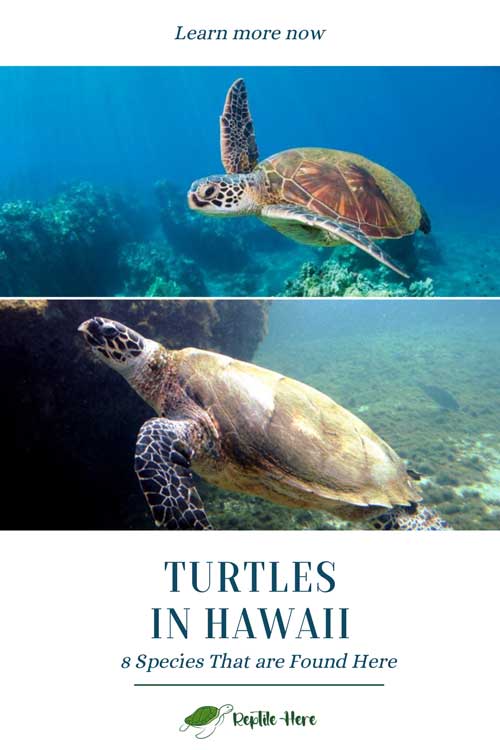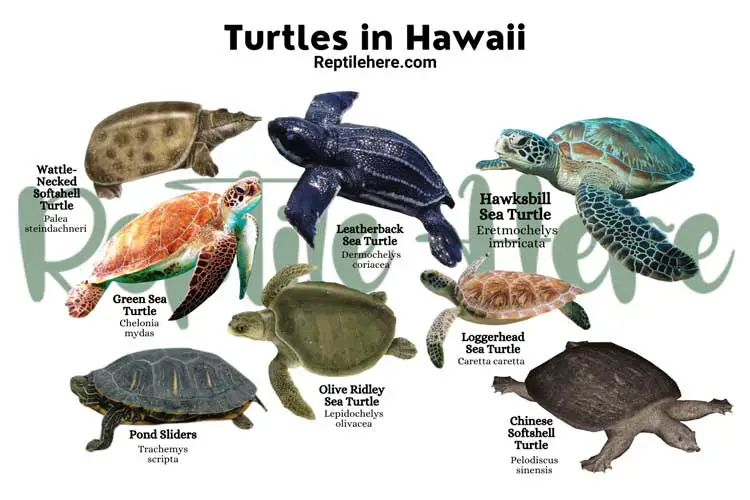Turtles in Hawaii – 8 Species That are Found Here
Hawaii is home to 8 species of turtles, most of which are sea turtles. So, if you’re planning for a sea turtle-watching excursion to the islands of Hawaii, you can rest assured that you’ll see the green sea turtles (locally known as Honu), which far outnumber the other types of turtles.
If you’re lucky, you may also spot a hawksbill sea turtle. But the leatherback, Olive Ridley, and loggerhead sea turtles reside the in the deeper, offshore waters and it’s rare to see them as an average visitor to the region.
You can also find freshwater turtles in Hawaii including pond sliders, Chinese softshell, and wattle-necked softshell, though these are non-native.
Below is the complete list of all the Hawaii turtles and the basics you need to know about each of them, including physical appearance, average adult size, what they eat, where they live, lifespan, and conservation status.
8 Types Of Turtles in Hawaii
Contents
1. Hawksbill Turtle
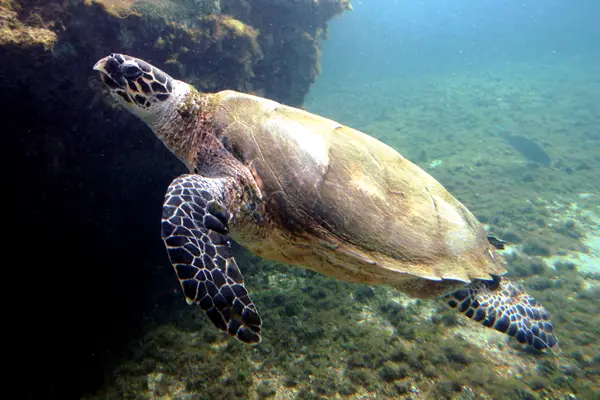
- Scientific name: Eretmochelys imbricata
- Common name: hawksbill turtle
- Family: Cheloniidae
- Size: 2.5 to 3 feet
- Lifespan: 50 to 60 years
- Conservation status: Critically endangered
Hawksbill sea turtles have been found in Hawaii on top islands like Hawaii, Maui, Oahu, and Molokai.
The adult has an average size of 3 feet and weighs around 180 pounds. The shell of this turtle features an amber upper shell with irregular light and dark streaks. They also feature predominant black and molten-brown easily radiating to the sides.
The shell tends to change color depending on the water temperatures.
This colored and patterned shell makes this turtle highly valuable and is commonly sold as “tortoiseshell” in the markets.
The hawkbill turtle is so named due to its narrow, pointed beak. It also has a distinctive pattern of overlapping scales on its shells which form a serrated look on the edges.
These turtles mainly feed on the sponge which they easily extract from reef crevices with the help of their narrow, pointed beaks. They also feed on jellyfish.
Hawkbill turtles are generally found in tropical oceans. While they live in the open ocean, they tend to spend more time in coral reefs and shallow lagoons.
During nesting, a female hawkbill turtle will look for small coves, “pocket” beaches, or inlets surrounded by rocks. They tend to travel high up the beach to lay eggs in shelters formed by the plants.
2. Leatherback Sea Turtle
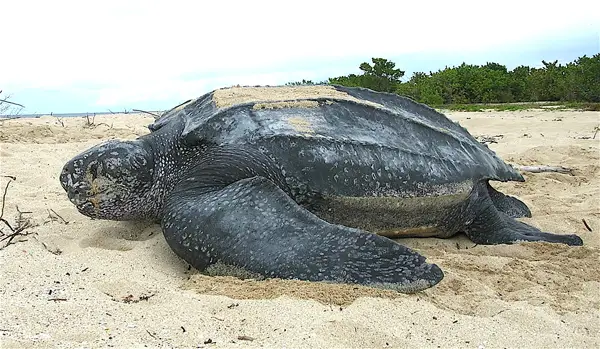
- Scientific name: Dermochelys coriacea
- Common name: Leathery Turtle, Lute turtle
- Family: Dermochelyidae
- Size: 5 to 6 feet
- Lifespan: 50+ years
- Conservation status: Vulnerable
The leatherback sea turtles are found in Hawaii state and are known to grow to mammoth sizes (up to 6 feet!). An average adult can also weigh as heavy as 540lbs!
Leatherback turtles usually have black shells. And they differ from other species of turtles with their smooth leathery carapace and skin. Their upper shell is made up of a flexible layer of dermal bones covered by tough and oily connective tissue and smooth skin.
The body of this turtle is barrel-shaped and then tapered to the rear. They have a total of 7 longitudinal dorsal ridges and their whole body is almost completely black, with some variable spotting.
Leatherback turtles in Hawaii have tooth-like cusps that work closely with their sharp-edged jaws to enable them to easily feed on jellyfish, salps, and other gelatinous zooplankton.
As for the habitat, these turtles of Hawaii are fond of tropical and subtropical waters all year round. But they tend to migrate to cooler, temperate, and boreal waters during warm weather.
Note that this species is highly migratory and can swim as many as 10,000 miles in a year between foraging and nesting grounds.
They’re also excellent divers—with the deepest diving record standing at whopping 4,000 feet!
3. Green Turtle

- Scientific name: Chelonia mydas
- Common name: Green turtle, Pacific green turtle, Black sea turtle
- Family: Cheloniidae
- Size: 2 to 5 feet
- Lifespan: 60 to 70 years
- Conservation status: Endangered
The green sea turtle species is classified among the largest hard-shelled sea turtles in Hawaii. It can reach up to 4 feet in length and weighs up to 400lbs.
This species is characterized by scutes that run down the middle; they’re 4 on each side. The shell color can be gray, dark brown, or olive with a yellow-to-white bottom shell or plastron.
It also features a serrated beak on its lower jaw and two large scales resign between the eyes.
Males are generally larger than females and have longer tails. The females lay their eggs on the beach and use their paddle-shaped flippers to easily burrow in the sand when laying eggs. A single green turtle can lay up to 200 eggs!
This Hawaii sea turtle species gets its name from its primary diet which consists of age and seagrasses (mind you, this diet is responsible for tinting its cartilage green).
Green turtles in Hawaii are usually found in tropical as well as subtropical waters throughout the years. They also tend to migrate to cooler temperatures and even boreal waters when the weather gets warmer.
4. Olive Ridley Sea Turtle
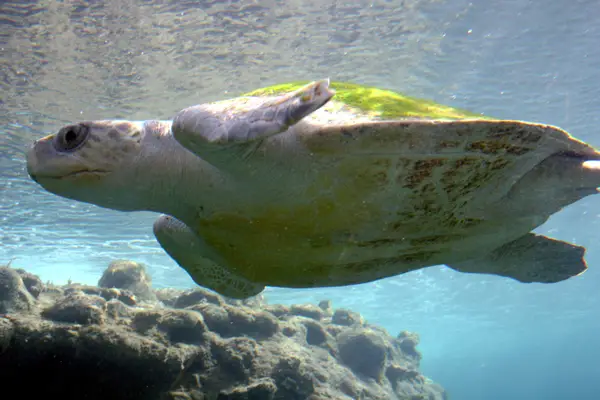
- Scientific name: Lepidochelys olivacea
- Common name: Pacific ridley sea turtle
- Family: Cheloniidae
- Size: 2.5 feet
- Lifespan: 50 years
- Conservation status: Vulnerable
Olive ridley sea turtles are much smaller than other species of sea turtles in Hawaii. They reach a maximum of 2.5 feet in length and weigh up to 100 pounds. And they have an average lifespan of up to 50 years.
An olive ridley sea turtle has a heart-shaped carapace with olive to grayish-green in color. The shell features around 5 to 9 scutes. These turtles are generally omnivorous and feed on crustaceans, fish, jellyfish, mollusks, algae, and salps.
These Hawaii sea turtles can opt to nest in large groups or by themselves. In the event of a mass nesting, the female turtles usually gather in large groups offshore on the nesting beaches. This is followed by a vast number of turtles moving ashore to nest (this event is usually referred to as arribada, a Spanish word for arrival).
The arribada is marked by numerous (hundreds of thousands) pregnant females coming ashore to lay eggs.
Due to the high density of nesting experienced at the nesting beaches in Hawaii, the females end up digging up clutches of eggs laid by other females as they try to find a place for their eggs.
Olive ridley turtles in Hawaii are usually found in tropical and subtropical waters all year round. Though they tend to migrate to boreal waters when the climate gets warmer.
Also read: Turtles in Tennessee
5. Loggerhead Sea Turtle
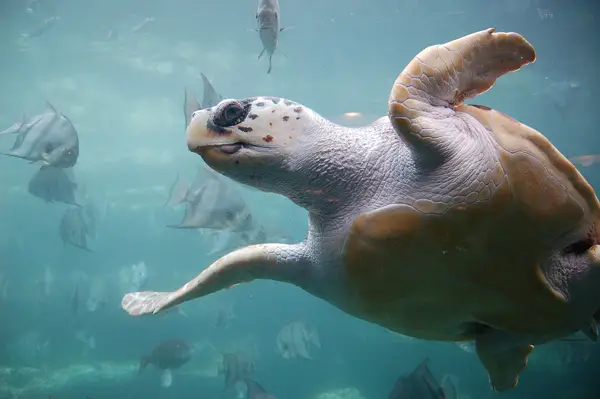
- Scientific name: Caretta caretta
- Common name: Loggerhead, Loggerhead Sea-Turtle
- Family: Cheloniidae
- Size: 3.5 feet
- Lifespan: 70+ years
- Conservation status: Endangered
Loggerhead sea turtles boast their place as the most abundant sea turtle species in the United States and are found in many states, including Hawaii.
These turtles are pretty big and can reach up to 3.5ft in length. They weigh up to 350 pounds and can live for a whopping 70 years or more.
A loggerhead is distinguished by a slightly heart-shaped carapace that’s reddish brown in color, with pale yellow plastron. Some species also feature yellow-bordered scutes.
This turtle species of Hawaii gets its name from its large head. It has powerful jaws that enable it to feed on a variety of foods including conch, whelks, insects, jellyfish, gastropods, and algae.
The loggerhead turtles in Hawaii are usually found in temperate, tropical, and subtropical waters all year round. However, they also tend to migrate to cold boreal waters on rare occasions.
6. Pond Sliders
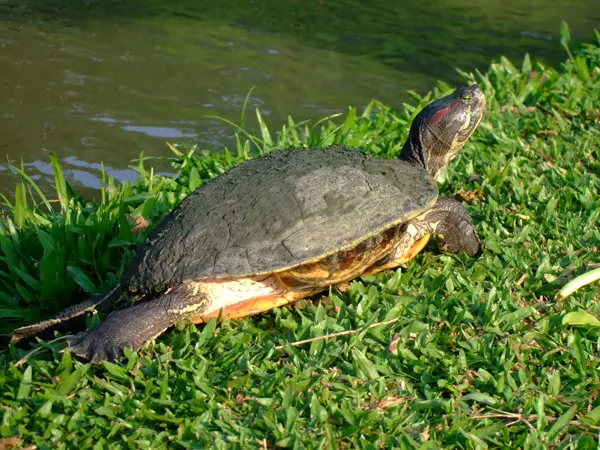
- Scientific name: Trachemys scripta
- Common name: Pond slider
- Family: Emydidae
- Size: 7 to 12 inches
- Lifespan: 30 to 40 years
- Conservation status: Least Concern
Pond sliders is a term used to refer to 3 sub-species of turtles namely yellow belly sliders, red-eared sliders, and Cumberland sliders. For all these 3 subspecies, the males are usually smaller than the females and have thicker tails.
Baby pond sliders are characterized by green shells and a yell-green or dark green skin color. But this color fades as they age. Males, in particular, tend to get darker. Their legs, neck, and head feature yellow marks and stripes alongside this dark appearance.
Red-eared sliders are often confused with painted turtles due to red markings at the jawline plus brightly colored stripes. However, their carapace is more rounded and helmet-like compared to those of painted turtles. Sliders are also bigger than painted turtles in captivity.
Pond sliders in Hawaii prefer living in slow-moving waters. The top islands in Hawaii where these turtles are common include Hawaii, Maui, Oahu, Molokai, and Kauai.
As for the diet, pond sliders are omnivorous but they’re more into eating vegetation in their adult age. The young ones are more carnivorous and will eat meat more.
7. Chinese Softshell Turtle
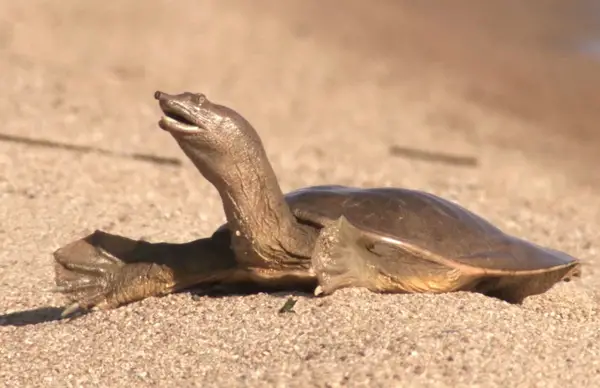
- Scientific name: Pelodiscus sinensis
- Common name: Chinese Softshell Turtle, Asiatic softshell turtle, dwarf softshell turtle
- Family: Trionychidae
- Size: 11 to 13 inches
- Lifespan: up to 25 years
- Conservation status: Vulnerable
As you can easily tell from its name, this turtle species is native to Asia. It found itself in the Hawaii islands as a result of Asian immigrants who used to hunt them for food between the period of 1800s and WWII.
A species of softshell turtle, this species of Hawaii has a leathery and flexible carapace, especially at the sides. The carapace usually has olive color and may feature dark blotches. And the lower side of the shell is orange-red and may feature dark blotches.
In terms of diet, this turtle is predominantly carnivorous and feeds on fish, mollusks, insects, and crustaceans. However, it will occasionally feed on aquatic vegetation.
This Chinese softshell turtle in Hawaii is highly aquatic compared to similar types of turtles. It is fond of swimming (it does this a lot!) and will only occasionally be seen venturing into the dry land.
It is mainly found in fresh as well as brackish water. In Hawaii, it resides in drainage ditches and marshes. Oahu is one particular Hawaiian island where these turtles are common.
Unfortunately, the population of this turtle species keeps declaiming and it has been labeled as vulnerable species by the IUCN. Countless specimens of this turtle are being bred for food, which further contributes to its population decline.
8. Wattle-Necked Softshell Turtle
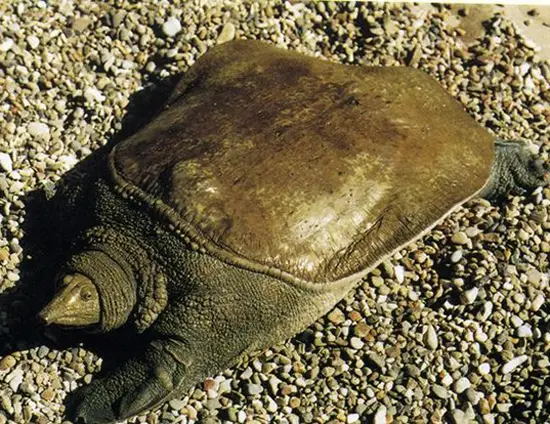
- Scientific name: Palea steindachneri
- Common name: Wattle-Necked Softshell Turtle, Steindachner’s soft-shelled turtle
- Family: Trionychidae
- Size: 14 to 18 inches
- Lifespan: up to 40 years
- Conservation status: Critically Endangered
The Wattle-Necked softshell turtle is another subspecies of the softshell turtle. And just like its cousin above, it came to Hawaii as a result of Asian immigrants who used it for food.
Mind you, the turtle is still heavily hunted around Asia for food.
The Wattle-necked softshell species of Hawaii prefer living in waterbodies with clear, running freshwater, e.g. mountain streams and rivers.
The turtle is mostly active at night when it swims around hunting or burrowing to ambush its prey.
This non-native Hawaii softshell also loves swimming. It will only occasionally swim up to the water surface and may make a rare trip to dryland to bask. But it spends most of its time underwater.
Wattle-necked softshell turtles in Hawaii are labeled as critically endangered species. Their most common threat is being poached for human consumption. This puts a lot of pressure on the wild population.
Related: Turtles in New Jersey
Conclusion
Sea turtles make up the largest group of turtle species in Hawaii. The most common turtle is the green sea turtle followed by the hawksbill species. The other sea turtles might be a bit harder to spot for an average visitor.
We have also discussed some freshwater turtle species found in the state including pond sliders and softshell, but these are non-native to Hawaii waters.
With all these sea turtle varieties, it’s no surprise that tourists travel to this state from far to watch the turtles.
Which of these turtle species would you like to go and watch on the Hawaiian beaches?
